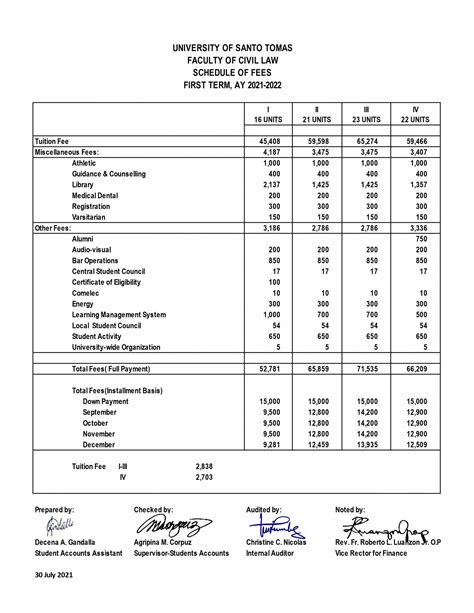Introduction: Navigating the Costs of a Prestigious Education
Embarking on the pursuit of higher education is a pivotal decision that comes with significant financial implications. When considering a renowned institution like the University of Santo Tomas (UST), understanding the tuition fee structure is crucial for informed decision-making. This comprehensive article delves into the intricate details of UST’s tuition fees, providing prospective students and their families with a clear understanding of the expenses involved.

UST Tuition Fee Structure: Unraveling the Components
The UST tuition fee consists of various components that contribute to the overall cost of education. These components include:
- Basic Tuition Fee: This is the core fee that covers the core coursework, lectures, and laboratories. The basic tuition fee varies depending on the student’s program, year level, and academic load.
- Miscellaneous Fees: These include fees for registration, library services, technology infrastructure, medical services, and student activities. Miscellaneous fees are typically charged on a per semester basis.
- Laboratory Fees: For programs that involve laboratory work, additional fees are charged to cover the cost of materials and equipment used in practical sessions. Laboratory fees vary depending on the specific program and the number of laboratory courses taken.
- Other Fees: Students may also incur additional fees for special programs, workshops, and other academic services. These fees are typically charged on an as-needed basis.
UST Tuition Fee Rates: Dissecting the Numbers
The UST tuition fee structure is designed to reflect the university’s commitment to providing high-quality education. Tuition rates vary depending on the student’s program, year level, and academic load. Here is a breakdown of the tuition rates for various undergraduate programs:
| Undergraduate Program | Tuition Rate per Semester (2023-2024) |
|---|---|
| Accountancy | Php 58,425.00 |
| Applied Mathematics | Php 58,425.00 |
| Architecture | Php 62,925.00 |
| Business Administration | Php 62,925.00 |
| Chemical Engineering | Php 71,425.00 |
| Civil Engineering | Php 71,425.00 |
| Computer Science | Php 66,925.00 |
| Electronics Engineering | Php 71,425.00 |
| Elementary Education | Php 58,425.00 |
| Food Technology | Php 66,925.00 |
| Industrial Engineering | Php 71,425.00 |
| Information Technology | Php 66,925.00 |
| Mechanical Engineering | Php 71,425.00 |
| Medical Technology | Php 66,925.00 |
| Nursing | Php 62,925.00 |
| Pharmacy | Php 71,425.00 |
| Physical Therapy | Php 66,925.00 |
| Psychology | Php 58,425.00 |
| Secondary Education | Php 58,425.00 |
| Tourism Management | Php 62,925.00 |
Note: Tuition rates are subject to change for the upcoming academic year. It is recommended to check the UST website for the most up-to-date information.
UST Financial Aid: Exploring Options for Financial Assistance
Recognizing that the cost of education can be a burden for some students, UST offers a range of financial aid options to assist students in covering their tuition fees. These options include:
- Scholarships: UST awards merit-based and need-based scholarships to deserving students. Scholarships can cover a portion or the full amount of tuition fees.
- Grants: Grants are awarded to students who demonstrate financial need. Grants typically do not need to be repaid.
- Student Loans: Students can apply for student loans from various banks and lending institutions to finance their tuition fees. Student loans require repayment after graduation.
Cost Comparison: UST vs. Other Universities
When evaluating the cost of education at UST, it is essential to compare it to the tuition rates of other reputable universities. According to the Commission on Higher Education (CHED), the average tuition fee for private universities in the Philippines ranges from Php 15,000 to Php 60,000 per semester. UST’s tuition rates fall within this range, making it comparable to other universities of similar caliber.
Table 1: Comparison of Tuition Fees in Private Universities in the Philippines
| University | Tuition Fee per Semester (2023-2024) |
|—|—|—|
| University of the Philippines Diliman | Php 15,000 – Php 30,000 |
| Ateneo de Manila University | Php 60,000 – Php 90,000 |
| De La Salle University | Php 50,000 – Php 75,000 |
| University of Santo Tomas | Php 58,425 – Php 71,425 |
Factors Influencing UST Tuition Fee: A Complex Ecosystem
Numerous factors contribute to the determination of UST’s tuition fee structure, including:
- Faculty and Staff Salaries: UST invests heavily in its faculty and staff to ensure the delivery of high-quality instruction and student support services. Faculty salaries account for a significant portion of the university’s operating expenses.
- Infrastructure Maintenance and Development: UST continually invests in the maintenance and development of its campus infrastructure, including classrooms, laboratories, and libraries. These investments contribute to the overall quality of the educational experience.
- Research and Innovation: UST is committed to fostering a culture of research and innovation. The university allocates resources to support research projects, academic conferences, and other initiatives that advance knowledge and contribute to societal development.
- Student Services: UST recognizes the importance of providing comprehensive student services, including counseling, health services, and career support. These services contribute to the overall well-being and success of students.
Evaluating the Value of UST Education: A Holistic Assessment
While the cost of tuition is a significant consideration, it is crucial to evaluate the value of education in totality. UST offers a range of benefits that contribute to its reputation as a leading university, including:
- Academic Excellence: UST has consistently ranked among the top universities in the Philippines,
